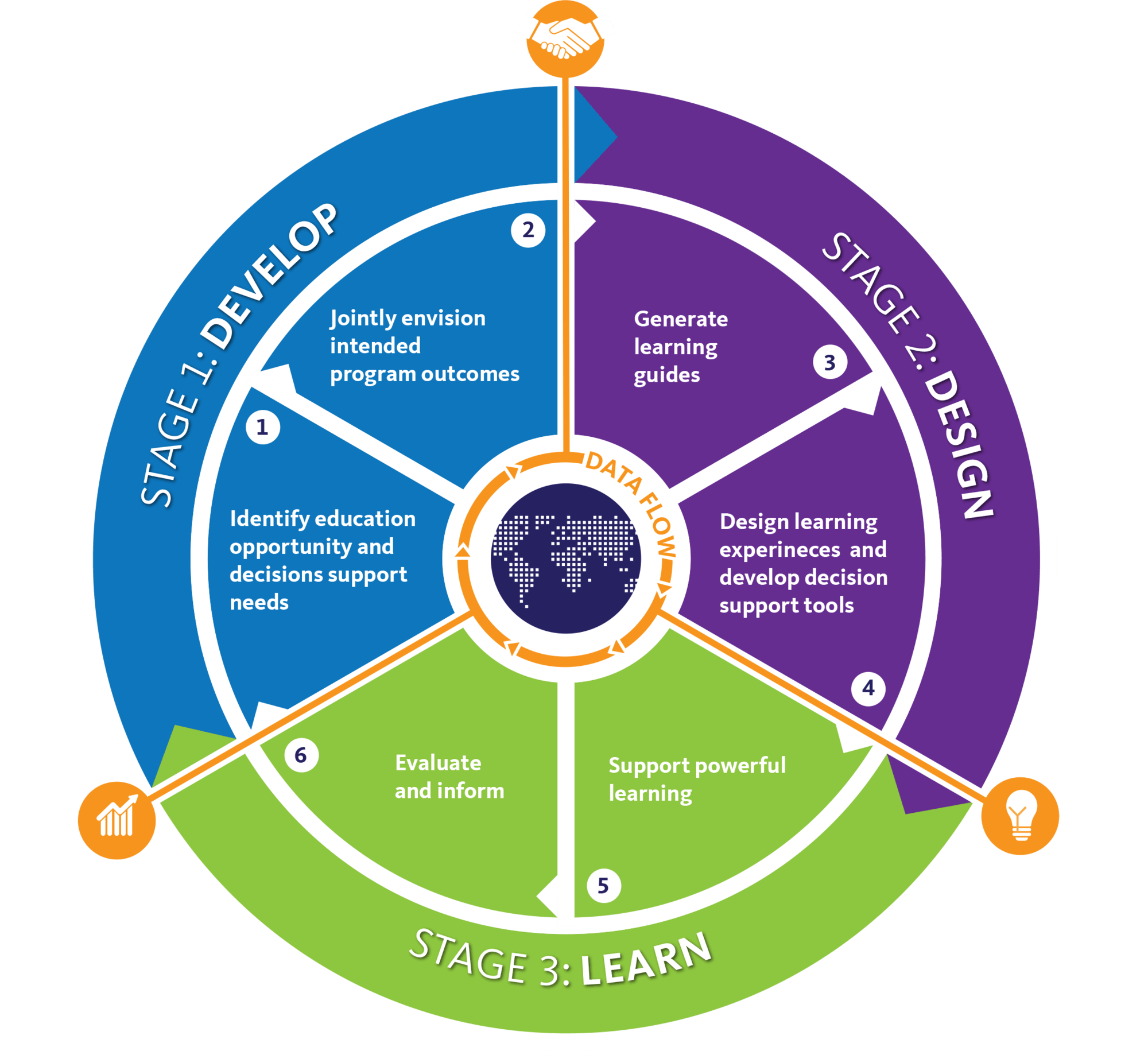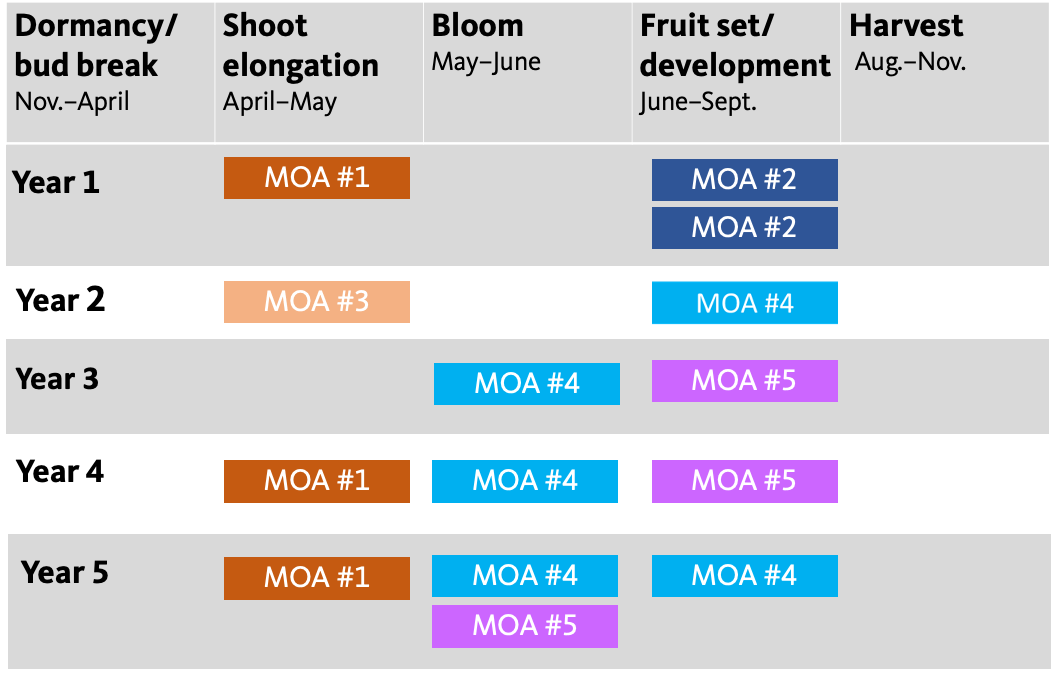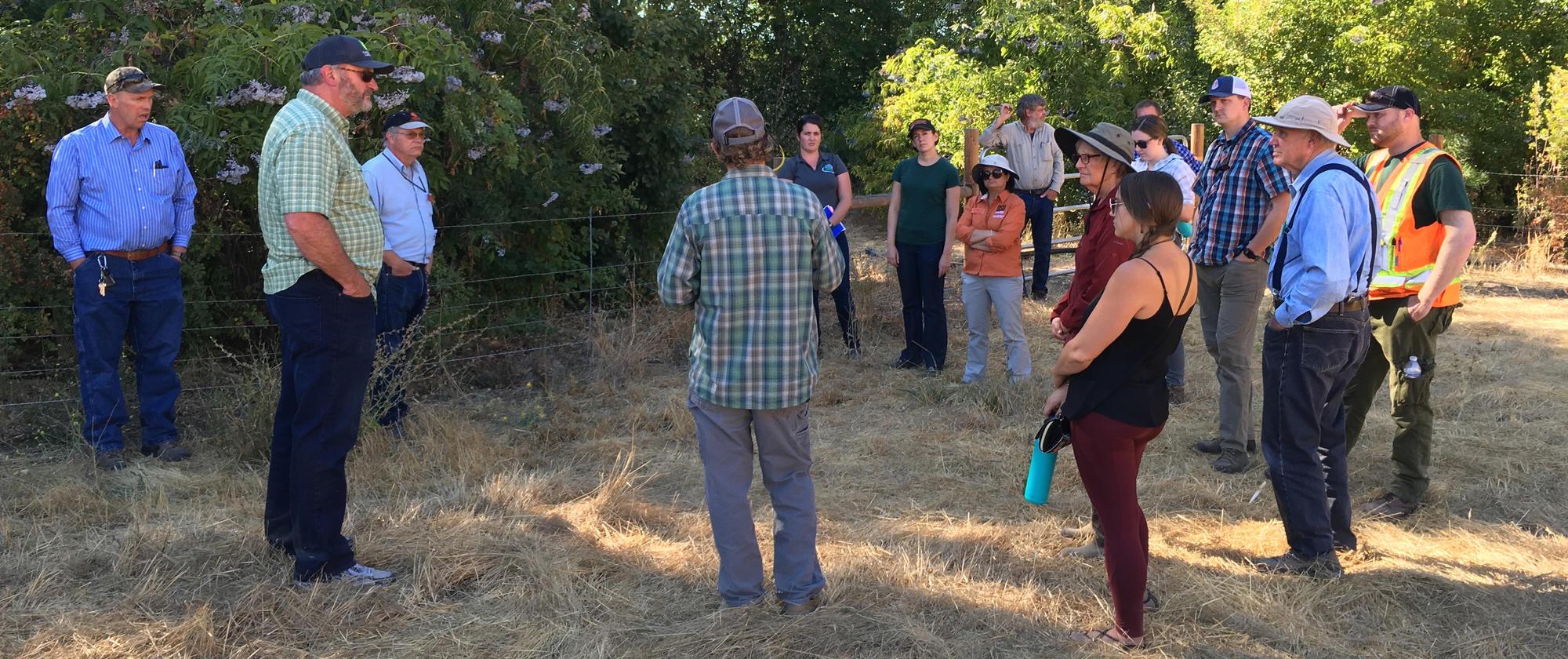Integrated pest management provides a valuable framework for addressing economically important pests. The process of adopting IPM strategies, however, is complex. Data that illustrate the efficacy of IPM practices are often difficult to understand and may require translation for use by farmers and practitioners. Producers are often encouraged to implement tactics that might be new to them, such as pest monitoring, economic thresholds and biological controls. They need guidance on how best to employ new tactics in a given production system to support adoption.
The challenge for IPM educators is to communicate relevant information to producers in order for them to consider the practical applications of research-based strategies. One approach is to include producers and practitioners in designing programs from the beginning to achieve realistic outcomes. A sense of collective ownership in the effort develops from their contribution to the program design and through the stages of implementation. Early on, the design team can quickly identify specific informational needs and feasible implementation options. Such information is invaluable for working through challenges in program development. This approach increases the likelihood of realizing the benefits of an integrated system.
This publication provides insights from our IPM work in Oregon with three separate Extension groups of adult learners. In each case, we worked with local stakeholders to develop the tools they needed to make more informed decisions. Extension faculty and staff working across content areas can use the lessons learned from our work to inform their outreach programs.
Adaptive Learner-Centered Education for Extension
The framework used to create the following partnerships was the Adaptive Learner-Centered Education approach (Adaptive Learner-Centered Education: A Toolkit for Extension, EM 9144). The three main stages of ALCE are: 1. Develop 2. Design 3. Learn (Figure 1).
Within the first stage of ALCE (Develop), consultations are held with stakeholders to envision the program’s desired outcomes. These outcomes are then used to design decision-support tools that integrate the necessary data for producers to make informed and sustainable choices (Stage 2, Design). Using stakeholders’ needs as the basis for the educational design, Extension faculty can create learning experiences focused on a given audience (Stage 3, Learn). These tailored educational experiences increase the adoption of improved IPM practices.
The ALCE approach was applied within the following three Extension initiatives to develop community partnerships and co-create educational programs:
- Cranberry pesticide resistance risk reduction to enable more informed pesticide use.
- Biological IPM for northeastern Oregon cropping systems to increase on-farm habitat for enhancing biodiversity and pest control.
- The Middle Rogue Pesticide Stewardship Partnership to support a diverse range of pesticide user groups in minimizing off-site losses to surface water.
CASE EXAMPLE 1. Preventing pesticide resistance in cranberries
Setting and situation
Cranberries are grown on the coast of Oregon, primarily in Coos and Curry counties. This crop is an important resource in the region, supporting approximately 100 farm families. Recently, cranberry growers have struggled financially due to poor market prices and export restrictions on certain pesticide chemistries. More than ever, the growers need tools to guide them in prioritizing pest management decisions to minimize unnecessary expenditures and maximize farm sustainability.
STEP 1: DEVELOP
Cranberry growers in the Pacific Northwest recognize the value of adopting pesticide management practices that prevent further loss of chemistries and protect their ever-narrowing financial margins. To address this challenge, a group of 22 stakeholders, including growers, Extension educators and crop specialists, met in 2017 to discuss the regional cranberry industry’s needs. The resulting document — An Integrated Pest Management Strategic Plan for Cranberries in Oregon and Washington, EM 9212 — identified growers’ priorities for education, research and regulatory action. The growers established that they were concerned that overuse of their preferred pesticides would cause pests to develop resistance and render these products obsolete. Pesticide use data from many local farms was captured in a reporting system. A review of this information confirmed the grower concerns. Many growers were not rotating pesticides and were using only one or two pesticide chemistries.
To design an effective program, the Extension educator engaged campus-based Oregon State University faculty and local industry leaders. This team-based approach allowed for the development of a workshop that used adult education methods to address the pesticide use challenges within this community. The intended learning outcomes for preventing pesticide resistance were to 1) adjust their pesticide selection processes and 2) utilize nonchemical practices as additional tools. It would have been easiest to give a presentation on the importance of pesticide rotation and tell them to “go, and sin no more.” However, that approach has not been overwhelmingly successful in the past. To go beyond this, the team examined the pesticide selection and application process from the farmers’ perspective. The team then asked what context farmers needed to reduce the risk of pesticide resistance. The goal was to get beyond the theoretical and down to the bare-bones information that a grower might take home and use from a practical standpoint. In answering this question, it became clear that they should focus on two areas:
- Pesticide mode of action, or MOA, which is the particular manner in which the pesticide works against the target.
- Mode of action rotation over time.
STEP 2: DESIGN
The instructional design that emerged from the Develop stage was a three-hour workshop on skill-building to develop pesticide rotations and integration of non-chemical pest management techniques. Educators used actual pesticide use data that verified the need for the program in the instructional design to increase engagement. To create the learning activity, instructors simplified actual annual and multiyear spray programs by color-coding each mode of action group (Figures 2 and 3). These visually designed scenarios served as the basis for an engaging learning activity focused on the two core concepts: mode of action and rotation.
An additional opportunity noticed during the design process was the improvement of the Cranberry Institute’s pesticide chart. This chart outlines the pesticides that are labeled for cranberries for each growing region in the U.S. The chart provides a wealth of information about each pesticide, including its mode of action. However, the chart alphabetized pesticides by trade name rather than by mode-of-action group, meaning the growers had to keep track of the MOA groups for all the possible pesticide selections. To improve this resource for the Northwest, the new design grouped pesticides by MOA first within each of the insecticide, herbicide and fungicide categories. The MOAs were then color-coded so that different classes could be easily identified. These charts now highlight mode of action and can be placed in a pumphouse or chemical shed for ready access.
STEP 3: LEARN
The Pesticide Resistance Management Workshop was set within the Oregon Cranberry School program in 2018 and was attended by 41 participants. The room was set up using round tables with five seats each to support peer-to-peer learning. The program started by revisiting the industry needs assessment coupled with the pesticide use dataset to set the stage for productive dialogue.
The visual design of the pesticide scenarios reduced the burden for learners in evaluating the degree of rotation within the spray programs and enabled a high level of engagement. A discussion of trade names indicated that growers sometimes think they are using a different MOA when using a new pesticide, when in fact all that has changed is the pesticide’s trade name. The project lead solicited input from the growers on each pesticide scenario and encouraged discussion on options for reducing the risk of resistance. This approach provided an opportunity to explore the merits and deficits of the particular program over a few growing seasons. A brainstorming session captured the range of nonchemical, cultural practices that serve as part of their IPM approach.
In a survey conducted following the workshop, growers reported a 28% increase in their confidence in making pesticide choices that properly rotate mode of action classes. Over 80% of the growers indicated that they would factor in the rotation of MOA class into future pesticide selection. Sixty-five percent indicated their intention to share the pesticide resistance management information with others. In the year following the Pesticide Resistance Management Workshop, the topic of pesticide rotation was reinforced several times via newsletter articles and on-farm workshops. At the 2019 Cranberry School, 84% of growers who shared pesticide spray plans for the previous growing season demonstrated that they had rotated chemistries (n = 20). All the growers reported an increase in knowledge or skills to manage pesticide resistance because of this training program.
Summary
Working in new content areas of interest to growers provided an opportunity to learn and engage with new partners. Educational design and teaching templates allowed for the program to focus on what growers needed to learn. The active engagement in the workshop, as well as follow-up activities, resulted in:
- Understanding of the importance of pesticide mode of action rotation.
- Documented implementation.
CASE EXAMPLE 2. New community partnerships build integrated pest management capacity for northeast Oregon cropping systems
Setting and situation
Various rotational cropping options make northeastern Oregon ideal for the production of high-quality turfgrass seed. The crops in these production systems include peppermint for oil, small grains, potatoes, sugar beets, oilseeds, forages, specialty seed crops and dry beans/peas. In Union County, such diverse crop rotations offer opportunity to break up pest life cycles between crops.
But pest management challenges remain within specific crops. Most problems occur in perennial crops, which may remain in production for three to eight years before rotation to a new crop. During this time, pest infestations such as insects, diseases and weeds can build up and become more difficult to control. In many situations, even the use of effective pesticides does not provide adequate control. This results in the loss of perennial crop stands too early in the rotation cycle. Management of key insect pests (such as cutworm, billbug and mint root borer) is of great economic concern, and control relies upon a limited number of pesticide products with variable efficacy. Some of these products contain active ingredients, such as chlorpyrifos, in which some or all crop tolerances are at risk of cancellation for registered use in mint and grass seed. Producers need new, diverse control alternatives as older chemistries are removed from use.
STEP 1: DEVELOP
To begin building new partnerships, OSU faculty facilitated an ALCE consultation with 23 growers, consultants and industry representatives in Union County. Organizers chose this method to more actively engage stakeholders in revealing pest management needs and plotting future outcomes of importance to the industry. They used a five-step process:
- The first step was to ask a forward-looking question of the group and then provide time for individual reflection. In this case the question was, “What do farmers and the local industry need to be able to do, with support from OSU Research and Extension, to minimize the impact of losing pesticide active ingredients?”
- Participants were asked to write action statements to share what activities and information they see as important to resolve problems facing their industry.
- Participants worked together to organize those actions into like categories (for example, biological control, pesticide resistance management, etc.).
- The fourth step challenged the participants to craft a set of future outcome statements through open discussion of all the action statements that the group generated. The group then worked together to write 10 priority outcome statements for their industry. As a result, the local industry created future research and educational outreach needs.
- In the final stage, the group voted for their top outcomes and identified expanding mint/grass seed IPM by developing effective biological control methods as the top priority.
The information collected through these steps supported OSU faculty in developing a new collaborative effort with the Xerces Society, the federal Natural Resource Conservation Service, the Union Soil and Water Conservation District, local native plant experts, the Western Region Functional Agricultural Biodiversity Work Group and local growers.
The members of the new Bio-IPM team began a project to develop learning strategies and content for introductory and advanced workshops, field tours, on-farm consultations and new decision-support tools with a focus on biological IPM.
In addition, the support within the community enabled a new collaboration between the Oregon IPM Center, University of Arizona Pest Management Center and OSU Extension Service. The results of the collaboration information were captured in two documents, Integrated Pest Management for Oregon, Washington and Idaho Mint Crops, EM 9299, in 2020 and Measuring the Economic Impact of Pests and Pest Management on Oregon Peppermint, EM 9309, in 2021. The process engaged stakeholders in generating useful publications for the design of programs and effectively communicating economic impacts, management challenges and trends in management activities.
STEP 2: DESIGN
The Biological IPM Program for NE Oregon is a series of learning events designed to build the skills and knowledge of participants interested in establishing on-farm projects for enhancing and sustaining beneficial insect populations. The program also seeks to improve the ecological services provided by enhancing existing on-farm habitats originally implemented to mitigate soil erosion. Three events developed include:
- Biological IPM 1.0 Workshop (completed) — The intended outcome was for participants to gain baseline knowledge of biological IPM. The program included four learning modules: an overview of conservation biological control, the common beneficial insect groups, options for managing pesticides that reduce impacts on beneficial insects, and on-farm practices to support beneficial insects. Two growers led interactive sessions to share their on-farm habitat projects with maps and imagery.
- Biodiversity Working for Farmers Tour (completed) — This tour was codesigned by OSU Extension and the Functional Agricultural Biodiversity Regional Workgroup to promote successes in biological IPM in northeast Oregon. Learners gained insights through hearing farmers share their experiences while viewing these on-farm habitat sites. Other experts contributed by sharing the specific roles of snakes, frogs and native plants within these habitats. Three learning stations provided interactive experiences with beneficial insect identification, methods for soil quality assessment and a birds of prey demonstration.
- Biological IPM 2.0 Workshop (in process) — The learning outcome for this workshop is to enable growers to develop a draft habitat enhancement plan using new decision-support tools. One tool is a table of common local insect pests and their natural predators (Table 1). Table 2 helps growers select locally adapted plant species that support desired beneficial insects and native pollinators. The workshop will alternate between mini-lectures on key pests and beneficial insects, habitat types, native plants, site preparation and time in small groups for farmers to work on their habitat enhancement plans. In advance of the workshop, local farm visits will be conducted to collect preliminary site assessments for pest management needs and potential sites for habitat enhancement.
| Natural enemies | Billbugs (Kentucky bluegrass) | Cutworms (grass) | Strawberry root weevil (mint) | Mint root borer (mint) | Lygus (alfalfa, other seed) | Clover case bearer moth (red clover) | Slugs (many crops) |
|---|---|---|---|---|---|---|---|
| Ground beetles | X | X | X | X | - | - | X |
| Rove beetles | X | X | X | X | - | - | X |
| Spiders | X | X | X | - | X | - | |
| Harvestmen | - | - | - | - | - | X | |
| Parasitic wasps | X | X | - | - | X | X | - |
| Parasitic flies | - | X | - | - | - | - | - |
| Predaceous wasps | - | - | - | - | - | X | - |
| Ants | X | - | X | - | - | - | - |
| Big-eyed bug | - | - | - | - | X | X | - |
| Damsel bug | - | - | - | - | X | X | - |
| Lacewing | - | - | - | - | - | - | - |
a Medford area planting dates may be 7–10 days earlier and extend 7–10 days later than dates indicated for western valleys.
b For many of the crops, the amount to plant should be divided into several plantings, 1 or 2 weeks apart.
c Use narrower spacings for small gardens
| Common name | Blooms early | Blooms midseason | Blooms late | Attracts beneficial insects | Attracts native pollinators | Notes |
|---|---|---|---|---|---|---|
| Trees (native species) | ||||||
| Black hawthorne | - | x | x | - | x | Riparian, berry producer, pollinator |
| Blue elderberry | x | x | x | x | x | Riparian, superfood, fast grower/big, berries |
| Rocky Mountain juniper | - | - | x | - | x | Slow grower, easy to establish, taproot, rare in Oregon (Wallowa County, Idaho border) |
| Flowers and forbes | ||||||
| Basalt milkvetch | - | x | - | x | - | - |
| Lupine spp | - | x | - | x | x | - |
| Penstemon sp. | - | x | - | - | x | - |
| Desert yellow fleabane | - | - | - | - | x | Dry site, spreading |
| Goldenrod | - | x | x | - | x | Long bloom, easy establishment, deer resistant |
| Table: Darrin Walenta. Sources: Gwendolyn Ellen, Oregon State University; Barbara Robinson, Colorado Plateau native plant list; Sandy Roth, The Plant Works; Sandy DeBano, riparian entomologist, Oregon State University; and Karen Antell, Eastern Oregon University plant biologist. | ||||||
STEP 3: LEARN
- Bio IPM 1.0 Workshop: In 2018, the first workshop, Biological IPM 1.0: Farmscaping for Biological Integrated Pest Management in NE Oregon Cropping Systems, introduced biological IPM with beneficial/predatory insects. In this program, participants engaged in visual learning exercises and group discussions that provided baseline knowledge of biological pest management and practices for supporting beneficial insects. The presenting farmers shared maps and habitat imagery to explain their projects' design, purpose and functions. A survey at the end of the workshop captured large changes in participants’ ability to identify beneficial insects, recognize resources that support beneficial insects and select practices that can conserve beneficial insects. All the participating growers reported that attending the workshop would influence future actions to support beneficial insects on their farms. Eighty percent of agricultural support staff and educators indicated they would change how they advise growers about farm management practices. “Farmer-to-farmer” engagement within this workshop also served to inspire growers to consider habitat enhancement projects in the future. This event also created new opportunities for growers to network with their peers and share their experiences with others.
- Biodiversity Working for Farmers Tour: In June 2019, the Agricultural Biodiversity Working for Farmers On-Farm Tour was held in Union County to help promote the use of biological IPM. This event focused on the conservation of existing on-farm resources that enhance pest suppression by insect predators and parasites. Forty-one participants toured two local farms to learn about current projects, soil-building techniques and alternative crop production practices that contribute to on-farm diversity. They also engaged in a panel discussion with growers and agency representatives that focused on successes and challenges of enhancing agricultural biodiversity and supporting ecological services on farms. A post-tour survey (n = 32) captured participant intentions. The majority (86%) of participants who were growers indicated they intend to change their farm management practices to conserve natural resources. A majority of these respondents plan to adjust tillage and mowing practices, provide resources for native pollinators and create new habitats for beneficial insects.
- Biological IPM in NE Oregon Cropping Systems 2.0: This advanced-level workshop, to be offered in 2021, will have hands-on and interactive activities for designing or improving on-farm habitat projects. This workshop, originally planned for 2020, was delayed due to COVID-19. The main outcome for this workshop is to enable participants to start the design process for habitat installation or enhancement projects they have considered for their properties.
Summary
These outreach efforts have brought about an enduring partnership among growers, university representatives, natural resource agencies, and grower and sustainable agricultural associations. This multifaceted group will continue to work together on complex issues to develop and implement effective biological pest management in northeastern Oregon. The evolving experiences of this grower community continue to serve as the basis for ongoing partnership-building across diverse stakeholder groups to meet current and emerging challenges. The Agricultural Biodiversity Working for Farmers Tour is a prime example of how new collaborative efforts can be created that result in expanded educational opportunities. The success of this program was evidenced by post-program evaluations and feedback from participants.
CASE EXAMPLE 3. Middle Rogue Pesticide Stewardship Partnership
Setting and situation
Aquatic ecosystems are sensitive to toxic compounds, and there are regulatory ramifications of surface water contamination. An important facet of IPM is protecting water bodies by mitigating off-target pesticide movement. The Bear Creek basin of the Rogue River Valley has a long history of fruit production, including tree fruit and wine grapes. Because of the proximity of agriculture in this region to creeks and streams, pesticide contamination is of concern. Pesticide monitoring has been conducted since 2016, funded by the Oregon Department of Agriculture and the Department of Environmental Quality.
A unique, voluntary approach in Oregon for reducing surface water contamination is the Pesticide Stewardship Partnership, or PSP. This state-level, multiagency program enables local groups to identify strategies within their watershed to reduce surface water contamination levels. Through this program, water quality sampling tracks progress and provides feedback to the community. In the Middle Rogue Watershed, a pesticide stewardship partnership enables the community to drive local solutions for mitigating off-target pesticides.
STEP 1: DEVELOP
In 2016, with the support of an Oregon Pesticide Stewardship Partnership program grant, OSU faculty facilitated two outcomes visioning sessions to explore interests and needs within this community. These sessions engaged growers, gardeners, consultants and agrichemical dealers with the task of maintaining effective pest control while reducing risks to water quality. The approach was similar to that used in Biological IPM for northeastern Oregon, with facilitators asking, “If you were able to manage the pests and weeds of concern to you while minimizing risks to aquatic life, what would you need to be able to do?”
- First, participants wrote down actions they would like to see through expanded communication, education and technical support. Those were then read aloud without commentary from the group. In welcoming and capturing all ideas, the facilitators encouraged participants to honestly share their thoughts without the fear that an idea would be rejected.
- In the second stage, responses were grouped into clusters. Participants were invited to ask questions or comment, allowing for them to learn from one another.
- Once responses had been grouped, participants identified four themes: education, communication, local rights and ordinances, and certification and land use incentives.
Out of the process, participants prioritized two groups as key outcomes for program design:
- The need to support further collective action on validated information and tools to implement higher levels of IPM.
- Getting the message out that everyone has a role in protecting surface water.
An insight from those initial sessions was the need to expand membership of the partnership to include others involved in water management in the region. For example, the facilitators came to realize that many of the pesticides detected were those with a broad range of use beyond commercial horticulture. Some materials were labeled for use on rights-of-way, while others are commonly used in lawn and landscape care.
The problem needed an approach targeting more than horticultural crops. Hiring an agronomist to fill a general agriculture Extension role at the center in summer 2017 provided a boost to efforts to reach a wider audience. The Middle Rogue Pesticide Stewardship Partnership was also broadened to include the Rogue River Watershed Council, Jackson County Master Gardeners and the Jackson County Roads Department. With more groups at the table, awareness and creativity was applied to the issue. Lastly, the listening sessions revealed that the program should not only provide general information on preventing off-target pesticide movement but also focused information specific to individual pesticides and use sites.
STEP 2: DESIGN
In 2017, a second partnership grant was awarded to the Rogue River Watershed Council to develop a five-year strategic plan, create a leadership structure and expand the partnership. The short-term effort of drafting the strategic plan allowed for close collaboration and required explicit discussion and agreement from all the partners about goals, both short- and long-term. This planning process allowed the partners to focus on their areas of expertise, including OSU Extension focusing on education and technical assistance rather than grant-writing and administration. Out of the strategic planning efforts, the partnership also created outreach groups to focus messaging and education to prioritize pesticide use-sites in the watershed. Pear and wine grape producers remain an educational group, and additional groups were formed around field crops, pasture, rights-of-way, forestry and urban settings.
To engage this wider range of users, an inaugural IPM Festival was held in 2017. The learning outcome was to select pesticide risk mitigation strategies to reduce the amount and number of pesticides entering surface water. To achieve this goal, a form was developed for the participants to identify new or altered pest and/or pesticide management practices they intended to apply after the program. Once selected, these potential actions were shared in small groups where participants could hear what other community members proposed to do to contribute to cleaner water. The learning activities integrated new human and environmental risk-based information to assist in balancing production and protection goals. Three tours allowed the group to explore real-world examples. These tours were to a small hay and grain farm with novel application practices, a tree fruit operation with a high level of IPM adoption and an organic vineyard.
In support of the strategic plan, the 2018 IPM Festival was designed to be useful to a broader range of community members engaged in managing pests with an emphasis on home gardens, landscape care, ecological restoration and agricultural production. The intended outcome for this event was to provide specific information for pesticide users and ensure peer learning across the diverse participant groups. The initial part of the day was used to share information that was relevant to all participants. Pesticide detections from the monitoring program, the basics of IPM across systems and routes and mechanisms of off-target movement of pesticides were shared in lecture and discussion sessions. Learners then selected a breakout group on assessing pesticide safety, research updates for orchards and vineyards, or safe and effective weed management in pastures to provide specific information relevant to those systems.
Participants then moved outdoors and watched a demonstration of testing equipment to evaluate the distribution of pesticide from an airblast sprayer. Additionally, two field tours highlighted several practices used to manage pests that also protect water resources. The first was a riparian restoration site to gain from the experience of the project manager in controlling invasive vegetation along waterways. The second was at an organic vineyard and orchard to learn about cultural pest management practices.
To provide information to nonagricultural community members, a set of five crop calendars was created to improve their understanding of pest concerns and pesticide application timings for crops in the region (Figure 6). A simplified table of the pesticides monitored by the program was also developed. The common Rogue Valley use sites for each pesticide were displayed in a grid, along with risks to surface water and groundwater.
STEP 3: LEARN
The first IPM Festival was attended by 25 learners. One teaching approach was two mini lectures with local partnership water quality data, examples of IPM for water quality protection and approaches for integrating IPM practices. After a group discussion, individual reflection time allowed participants to complete a new “Intended Actions to Protect Surface Water” form. Participants then formed small groups where they had the opportunity to share their next steps to protect water quality in their specific settings. The participants were encouraged to take these forms home to help in making progress following the conclusion of the festival. The evaluation data showed that the program increased the participants’ awareness about the pesticides of concern and plans to alter their intended pesticide application practices. Two-thirds of respondents indicated that they would use weather forecasting more often to time pesticide applications. Self-assessed changes in skills showed gains in the ability to select practices that will work in a given pest management setting.
The 2018 IPM Festival was attended by a diverse audience, including commercial and home pesticide applicators as well as interested citizens. Of those participants who applied pesticides, 90% stated they would adopt practices they had learned during the IPM Festival with the aim to reduce off-target pesticide movement. Two months after the 2018 IPM Festival, participants completed a follow-up survey. The results indicated that what they learned at the IPM Festival enabled them to change one or more management practices to protect surface water quality. Participants rated the spray pattern demonstration as highly useful and relevant. Participants and partners found that the broader audience made the event more engaging through sharing ideas across pesticide user groups and allowing for a better understanding of the needs and challenges.
Pesticide detections continued through 2018, as did outreach events. Evidence from these detections highlighted benefits of this collaborative program. For example, the county roads department reduced the use of one herbicide which was often detected in the watershed. Recently, the detection frequency of that material has begun to decline. Another example involved a focused sampling effort that targeted detections of one herbicide in one sub-watershed. This effort was made possible by the increased number of Pesticide Stewardship Partnership partners who could assist with the sampling “blitz.” Though nursery production is a relatively minor land-use in the region, this effort identified and engaged one nursery manager in the partnership. Based on a drop in detections of that herbicide following the outreach, it appears that this nursery may have had an outsized contribution to off-site pesticide movement.
Summary
While ultimately it is the actions of individuals that prevent off-target movement of pesticides, it takes a partnership to raise awareness and reduce pesticide contamination throughout the watershed. The broadening of the Pesticide Stewardship Partnership beyond the agricultural applicator communities resulted in the success early in this initiative and has helped to maintain the momentum of the partnership in moving forward. Implementation of the strategic plan will continue over the coming years. The plan aims to yield fewer detections of pesticides as well as increase adoption of IPM practices across land uses. The Middle Rogue Pesticide Stewardship Partnership strategic plan is the first of its type in Oregon and is being used as a template for the planning processes for other partnerships around the state. Check out the Middle Rogue Pesticide Stewardship Partnership for updates on the implementation of the strategic plan and ongoing monitoring and education.
Conclusion
The program development processes implemented in these case examples are transferable to many Extension content areas. The lessons learned and new insights by element of the ALCE approach (Figure 1) are:
STEP 1: DEVELOP
Through collaborative, interactive needs assessments with stakeholders, we identified the most valued and relevant priorities for growers. This step in the process enabled each project team member to see how their experience would contribute to achieving the learning outcomes using their unique knowledge, skills and experience. When further expertise was needed, we identified and recruited new members to leverage knowledge, including on-the-ground experience. Through broadening the experience and perspectives of the teams, the impact of the projects increased and the project networks expanded. The clarity of shared goals kept the momentum high. Team members were deeply engaged and motivated to create locally relevant outreach and customized informational resources.
Insight: Programs that use a team approach and engage with a range of community members align diverse interests and reach a broader range of expertise to create locally tailored IPM educational programs.
STEP 2: DESIGN
When the desired outcomes for each partnership were clearly identified, it became more obvious what learning activities and information were essential. Through an intentional curriculum design process, we helped others become more effective instructors and enabled deeper learning within the communities. Incorporating local data into new forms of decision-support information also empowered learners to practice making choices that enhanced the adoption of sustainable agriculture practices. Ultimately, these customized resources serve to provide actionable information that the learners use in their decision-making process.
Insight: Framing pest and pesticide management as a collective, communitywide issue can broaden the number of stakeholders invested in making positive changes.
STEP 3: LEARN
All adults have a wealth of life experience that can benefit the community. Clear, commonly held goals unleashed the power of co-learning by inspiring local innovators to share their knowledge. In addition, our learner-centered teaching plans ensured adequate time for skill building, interaction and reflection. Self-directed learning activities allowed the participants to choose what works for them and increased their confidence in applying new practices in their approaches to land and crop management. Within the teams, members completed After Event Reflection forms, and the collective insights were shared across projects to enable improvements to future programs.
Insight: Encouraging peer-to-peer learning reduces the pressure on facilitators to “have all the answers,” capitalizes on growers’ extensive experience and knowledge, and fosters a feeling of program ownership among growers.
This collaborative work has brought about a range of outputs:
- Larger teams and expanded networks that continue to creatively address community challenges and pursue opportunities.
- A team-based reflective learning process.
- An award-winning Extension Annual Conference session on teaching and learning.
- Further project funding opportunities.
- A statewide Extension Teaching Network that gathers monthly.
- This publication.
Respectfully crafted Extension education programs that rely upon local knowledge, two-way learning, and the latest research can help address pest management challenges and increase opportunities for IPM implementation.
This material is based upon work that was supported in part by the National Institute of Food and Agriculture, U.S. Department of Agriculture, under award No. 2015-38640-23779 through the Western Sustainable Agriculture Research and Education program under subaward No. EW16-010. USDA is an equal opportunity employer and service provider.









